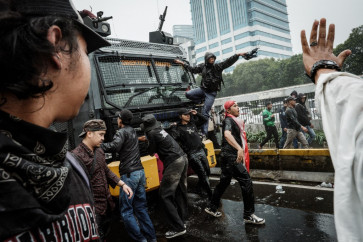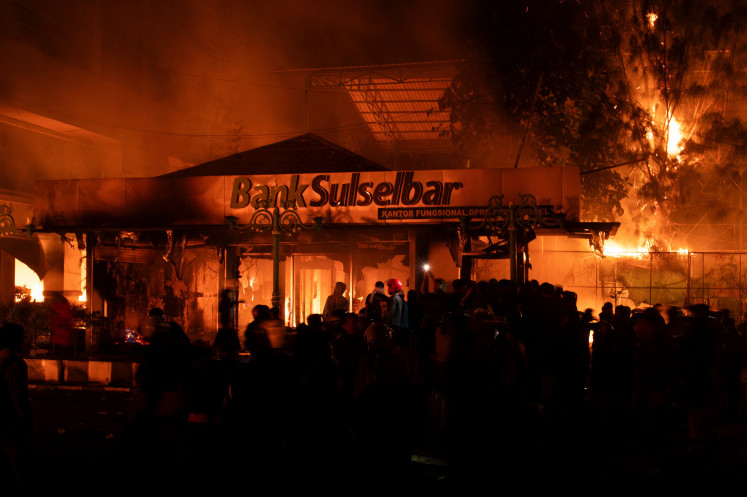Popular Reads
Top Results
Can't find what you're looking for?
View all search resultsPopular Reads
Top Results
Can't find what you're looking for?
View all search resultsInequality, migrant gaps in High-Level Panel report
After working for more than two years, the High-Level Panel of Eminent Persons on the Post-2015 Development Agenda has finally submitted its report to UN Secretary-General Ban Ki-moon
Change text size
Gift Premium Articles
to Anyone
A
fter working for more than two years, the High-Level Panel of Eminent Persons on the Post-2015 Development Agenda has finally submitted its report to UN Secretary-General Ban Ki-moon.
The report will be deliberated in the UN General Assembly from September 2013 until 2014.
A most welcome breakthrough of the report is evident in four desirable goals: Ending extreme poverty by 2030; empowering women and girls, including ending violence against women and securing property rights for women and mothers; strengthening the quality of governments upholding freedom of information and association and reducing corruption; and reforming global partnerships and the financing of development, including the reduction of illicit flows and tax evasion from countries like Indonesia.
For Indonesian civil society groups, the post-2015 report process represents a better approach to policy making at the international level.
The panel's report was developed through an open, consultative and participatory process, including the participation of civil society organizations (CSO), youth and women groups.
The panel comprises Indonesian President Susilo Bambang Yudhoyono, UK Prime Minister David Cameron and Liberian President Johnson Sirleaf, representing the North and South, lower-income, middle-income and high-income countries.
Apart from the positive outcome, the report has two major gaps related to inequality issues and migrants rights. If the gaps are left unaddressed, they will undermine efforts for transformative shifts both in Indonesia and the world.
Regarding inequality, the report is rather weak and noncommittal. Inequality is addressed but not broken down into indicators and targets to be achieved. The report opts 'to end extreme poverty' instead of 'to end poverty and reduce inequality'. The report prefers not to set the global target on inequality and leave it to national policy to decide.
This is a 'grand, missed opportunity' for leaders to stem the worldwide rising trend of inequality both in middle- and high-income countries, including in Indonesia.
The report recognizes the problem of inequality: The 1.2 billion poorest people account for only 1 percent of world consumption while the billion richest consume 72 percent; many people living in poverty have no fair chance in life as they are victims of illness, unemployment, natural disasters, local conflict, poor local leadership, or low-quality education; others face discrimination.
One might have little concern about income inequality, and for good reason. But we must care about the inequality of life chances, which stems from the inequality of income and opportunity. Reducing
inequality ' both of income and opportunity ' is hugely strategic in a broader sense as it increases the legitimacy of democracy and creates more cohesive societies.
A simple indicator of inequality of life chances in Indonesia and other countries is to look at contributions from the rich and poor to tax revenues, and how much the revenue is being turned back into public goods for citizens and economies, such as for cities and rural infrastructure, health and education facilities.
In Indonesia, the elite and corporations only contribute to 12-13 percent of tax revenues compared with an average 25 percent in middle-income countries and 35 percent in high-income countries. Based on an International Monetary Fund (IMF) estimate, Indonesia should have doubled its tax ratio. Why is a low tax ratio easily understood but extremely hard to tackle? It is partly due to corrupt tax officers like Gayus Tambunan and widespread tax evasion by both multinational and national enterprises.
On the spending side, only a little of the Indonesian budget is allocated for social issues and infrastructure. Most of the social spending is on fuel and agricultural subsidies, such as for fertilizer and seeds, which are controlled by ruling politicians.
The high rate of maternal mortality in Indonesia is a classic example of how the priorities and effectiveness of development spending require 'transformative shifts', to borrow the key word of the report.
Indonesia needs to double its social investment, such as magnetic resonance imaging (MRI) and doctors and midwives in hundreds of districts that lack medical workers and proper facilities.
The inequality of life chances is also evident in social protection sector. More than half of the population in Indonesia is not covered by any social protection if they are sick, jobless, old or dead. Hundreds of regencies in the eastern and western parts of Indonesia lack proper education, health and sanitation infrastructure.
Indonesia's mid-term development plan 2015-2019 would be improved by adding the reduction of inequality as an indicator of success. Indonesia would also need to revise and update its poverty and inequality data: the number of poor before tax and transfer and the number of poor after tax and transfer. Indonesia must revise its current poverty measurement by moving away from 'absolute poverty' to 'relative
poverty' measurements.
Social and antipoverty programs need to be improved and expanded. The expansion of beneficiaries and the value of conditional cash transfers (PKH) for poor mothers and children across Indonesia will greatly reduce the inequality of life-chances for mothers and children under-five.
The second concern of the report is the fact that the report does not set a target and indicators to protect and promote the rights of migrant citizens, especially in host countries like Saudi Arabia and Malaysia.
In the analysis, the report states: (i) the universal human rights and fundamental freedoms of migrants must be respected; (ii) these migrants make a positive economic contribution to their host countries, by building up their labor force; (iii) sending countries benefit from getting foreign exchange in the form of remittances and from greater trade and financial flows with countries where they have a large diaspora; (iv) by 2030, as the global population rises, there could be 30 million more international migrants, remitting an additional US$60 billion to their home countries through low-cost channels.
Countries like Indonesia, Brazil and the Philippines are sending more and more migrants abroad.
Compared to low-income countries, Indonesia relies more on remittances and tax as the biggest sources of fiscal revenue than from international aid and loans. But at the same time, many Indonesian migrant workers experience torture, rape and violence in many receiving countries.
The report could formulate solutions, not just analysis, for migrant citizens by recognizing their rights and obligations as citizens, including freedom from the torture, rape and violence that besets many Indonesian domestic workers.
One target and indicator is to encourage higher standards for receiving countries to respect and protect the rights of migrant citizens.
They are not just workers; they are all citizens who are making livelihoods for themselves outside of their original countries.
The writer is the executive director of the International NGO Forum on Indonesian Development (INFID), Jakarta.










